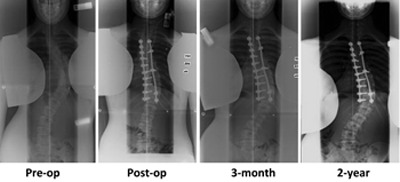Lowest instrumented vertebra selection linked to distal adding-on in Lenke 1A scoliosis
In Lenke 1A-type scoliosis, the selection of the lowest instrumented vertebra is highly associated with the onset of the distal adding-on phenomenon, according to researchers in Denmark.
Distal adding-on, or a curve that continues to progress after surgery, often leads to unsatisfactory clinical results and a high risk of reoperation. There are two potential causes, Yu Wang, MD, PhD, in the orthopaedic department at Aarhus University Hospital, in Aarhus, Denmark, said. One is the patient is skeletally immature at the time of surgery, and therefore, the deformity may still progress postoperatively. The second hypothesis is that inappropriate selection of the lowest instrumented vertebra causes distal adding-on, meaning that at the distal end of the fusion, the extent of the fusion is too short to maintain the correction adequately.
“However, in the literature, there are very limited proofs to support this hypothesis,” Wang said at the 12th EFORT Congress 2011.
Wang and colleagues identified 278 adolescent idiopathic scoliosis patients treated at Aarhus University between 2002 and 2008. They included patients with Lenke 1A scoliosis treated with posterior pedicle screw-only constructs and 1-year radiographic follow-up, minimum.
|
Image: Wang Y |
Of the 45 patients — all girls — that met the inclusion criteria, researchers assigned 23 girls to the adding-on group and 22 girls to the no adding-on group.
The researchers tested several potential risk factors for distal adding-on: age at surgery, preoperative Cobb angle, correction rate, and the preoperative location of the lowest instrumented vertebra with reference to end vertebra, neutral vertebra, stable vertebra and the central-sacral vertical line.
Statistical analysis revealed that selection of LIV (lowest instrumented vertebra) was correlated with distal adding-on, according to Wang. “With a multiple logistic regression model, we found the pre-op location of the LIV with reference to the central-sacral vertical line is most correlated with distal adding-on,” he said.
Wang and colleagues found pre-operative Cobb angle, correction rate and neutral vertebra-LIV difference were not associated with the onset of distal adding-on.
The researchers compared the ways to select the LIV: end vertebra, neutral vertebra and stable vertebra and tested a new strategy of choosing the first vertebra in the cephalad direction from the sacrum with a translation that exceeded 10 mm.
Based on the results, choosing the end vertebra as the LIV did not prevent distal adding-on, and selecting the end vertebra plus the first vertebra below it as the LIV resulted in the unnecessary fusion of many additional segments, Wang said. Using the new method, however, produced satisfactory results in both the adding-on and no adding-on group.
“We conclude that choosing [this new method] of LIV may provide the best outcome as it not only prevents distal adding-on but also conserves more lumbar motion and growth potential,” Wang said. – by Colleen Owens
Reference:
- Wang Y, Bunger C, Hansen ES, et al. Distal adding-on phenomenon in Lenke 1A scoliosis: risk factor identification and treatment strategy comparison. Paper #2963. Presented at the 12th EFORT Congress 2011. June 1-4. Copenhagen, Denmark.
- Yu Wang, MD, PhD, can be reached at Nørrebrogade 44, 8000, Aarhus C Denmark; +45-78464162; email: yu.wang@ki.au.dk.
- Disclosure: Wang has no relevant financial disclosures.


